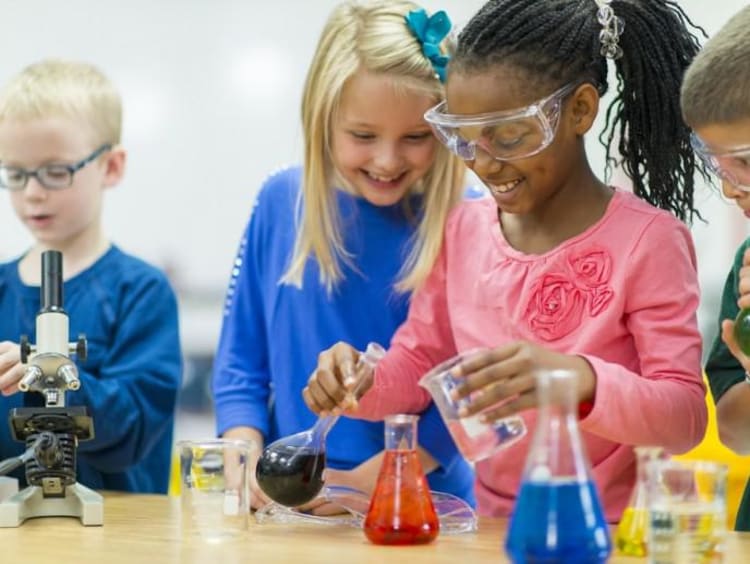The Scientific Method: Critical Thinking at its Best
By MJ Tykoski, MEd
Alumna, College of Education

Experiments are a great way to incorporate higher level thinking into the science classroom. When you ask a science teacher to describe the experiments he or she conducts in class, you will get a variety of responses.
While some teachers like experiments with simple demonstrations of science concepts that students already know, such as dropping a golf ball to demonstrate gravity, others equate experiments with projects that drag on for weeks (and too often end up being done by the parents, not the students).
Importantly, though, and regardless of the time invested, it is critical that students actually use the Scientific Method. Truly understanding the Scientific Method can help teachers integrate more critical thinking into their classrooms.
The essence of the Scientific Method is testing with the aim to falsify. To achieve this, one should have a testable hypothesis, collect data and then use that data to conduct a test in an attempt to falsify the hypothesis.
Using the Scientific Method in the Classroom
Here is a simple classroom example: After studying signs of a chemical reaction, a teacher can present two chemicals that the students have not seen before. The students must state a hypothesis; either the two chemicals will react when mixed or the two chemicals will not react when mixed.
The teacher then mixes the chemicals and lets the students observe and gather the data, or if the reaction and products are safe, they can give the students instructions to conduct the mixing experiment on their own.
Students then use their observations and data to determine whether their original hypothesis has been falsified. A simple framework to use for this is the Claim, Evidence and Reasoning Method (McNeill and Krajcik, 2012). Students make a claim if their hypothesis is true or false, use evidence to justify their claim and then explain the scientific reasoning.
Helping Students Understand the Scientific Method
Over the years, I have found that students are challenged about the concept of falsifying the hypothesis. They hold to the misconception that science is about “proving” something to be true.
Early in my teaching career, I decided to find a way test my suspicions about the students’ almost ingrained programming of this misconception. For a classroom experiment, I provided students a hypothesis to test about motion. They were given a toy car, a clay snowman balanced upon the car, a stack of books, a ramp and a curb made of a pencil at the base of the ramp.
The hypothesis I presented to them was: “The higher the ramp, the less distance the clay snowman will fly when his car hits the curb.”
Students intuitively knew this contradicted their own life experience prior to the experiment. They performed the experiment and invariably had data that contradicted the hypothesis.
Yet, they were so scared of having a hypothesis that was not true, that I watched in amazement as students erased data and made up numbers to use just so they could say the hypothesis was right. This was an epiphany for me, and it continues to shape much of what I do in my science classes.
Science is about attacking the hypothesis and changing variables to see if, despite one’s best efforts, the hypothesis can be disproven (Bobrowsky, 2007). In science, it is perfectly acceptable for a hypothesis to be falsified with data support. If it was not, then “Mythbusters” Adam Savage and Jamie Hyneman would not have had a wildly successful show for 15 years!
Once students get over the mental block of, “the hypothesis is supposed to be true,” then the concept of disproving ideas, and the realization of the power of the Scientific Method opens up a new realm of critical thinking.
An idea that turns out to be false can teach us just as much as an idea that turns out to be true. There is no limit to what we can discover about the world around us through the diligent application of the Scientific Method.
Interested in learning about education degrees at GCU? Visit our website or contact us today using the Request More Information button at the top of the page.
References:
- Bobrowsky, M. (2007). The process of science and its interaction with non-scientific ideas. Washington D.C.: American Astronomical Society.
- McNeill, K.L. & Krajcik, J.S. (2012). Supporting grade 5-8 students in constructing explanations in science: the claim, evidence, and reasoning framework for talk and writing. New York, NY: Pearson.
More about MJ:
MJ Tykoski is completing her 21st year as a science teacher in Texas. Grand Canyon University provided the perfect opportunity for her to pursue her studies while staying in the classroom through their online master’s teaching degree. Given her interest in staying in the classroom and helping other teachers, GCU’s educational leadership program was a perfect fit for her needs.
She was the Middle School Science Teacher of the Year for the Science Teachers’ Association of Texas in 2009, state finalist for the Presidential Excellence in Math and Science Teaching in 2011 and the winner of the Texas Medical Association Middle School Teacher of the Year in 2013. For the last 17 years, she has worked with education and public outreach for NASA’s Stratospheric Observatory For Infrared Astronomy (SOFIA) and flew as part of the Echelon Cross Echelle Spectrometer (EXES) team in 2015.
The views and opinions expressed in this article are those of the author’s and do not necessarily reflect the official policy or position of Grand Canyon University. Any sources cited were accurate as of the publish date.


